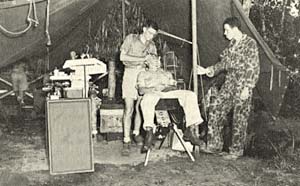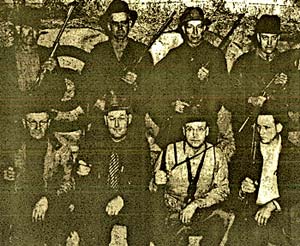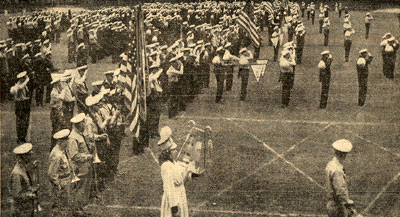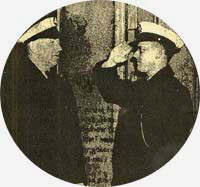Civilians in Military Drill
 The War Department mobilized the Oregon National Guard in 1940, leaving a void in the state that was eventually filled by the Oregon State Guard after the attack on Pearl Harbor. The Oregon National Guard's 41st Division went on to provide distinguished service in the Pacific theater. Shown above is the makeshift dental clinic of the division's Headquarters Company in New Guinea in 1943. (Image courtesy U.S. Army)
The War Department mobilized the Oregon National Guard in 1940, leaving a void in the state that was eventually filled by the Oregon State Guard after the attack on Pearl Harbor. The Oregon National Guard's 41st Division went on to provide distinguished service in the Pacific theater. Shown above is the makeshift dental clinic of the division's Headquarters Company in New Guinea in 1943. (Image courtesy U.S. Army)
The War Department called up Oregon's National Guard to federal service on Sept.
26, 1940 as part of a larger mobilization in the wake of the collapse of western Europe to Nazi forces. This left the state without a force to respond to large-scale emergencies. Local police forces could be called upon, but their ranks would also be thinned during the war by large numbers joining the military. The Army could bring forces to the state in the event of an attack, but how long would it take for help to arrive? Would it be too late? These questions occupied the minds of many Oregonians before Pearl Harbor but the call for answers gained urgency after Dec.
7, 1941.
Debate Over a "Home Guard"
The debate over whether to form some sort of "home guard" or state guard carried on through 1940 and 1941 in Oregon. Even local posts of veterans groups such as the American Legion and the Veterans of Foreign Wars held
differing opinions on the issue. The Hermiston Post of the American Legion was strongly in favor of organizing a home defense plan and pressed Governor Sprague to move forward in October 1940: "We feel a defense unit is justified at this point, as there are numerous ideal targets in this vicinity which would no doubt appeal to an enemy. A summary consists of irrigation reservoirs, grain ware houses, grain and oil docks, mainline railroads to the three compass points, railroad roundhouse and yards, and approximately four million gallons of gasoline and oil storage all within a radius of seven miles of our city and Legion Post." The group boasted 100 people in the vicinity, "all veterans of the last World War which should be sufficiently trained men to handle any size unit that you might wish to enlist at this point."
Footnote 1
 Salem veterans came to the defense of the non-veteran Oregon governor after critics assailed Sprague's failure to form a state guard in the months before Pearl Harbor. Oregon State Capitol in Salem. Image no. 20160310-9191, Oregon Scenic Photos, OSA.
Enlarge image
Salem veterans came to the defense of the non-veteran Oregon governor after critics assailed Sprague's failure to form a state guard in the months before Pearl Harbor. Oregon State Capitol in Salem. Image no. 20160310-9191, Oregon Scenic Photos, OSA.
Enlarge image
Some groups mounted "an aggressive campaign" to force the formation of a state guard, prompting the Salem post of the Veterans of Foreign Wars to come to Sprague's defense. They decried the fact that "Governor Sprague is being daily submitted to unwarranted attacks and abuse, including aspersions upon his competence to pass upon this issue because he 'is not a military man'...." The Salem veterans condemned the "publicity seeking attacks" that "can only result in furthering the mass hysteria that is so destructive to the full exercise of sober thought and consideration...."
Footnote 2
For his part, Sprague stuck to his guns. Early on he had outlined a state guard plan but "it will not be put into effect until the need therefor becomes apparent."
Footnote 3
Debate also centered on how the guard would be organized. Would it be a highly centralized force or
localized? Mark Weatherford, an Albany attorney, counseled the governor to choose the local approach because of the speed with which local forces could respond: "There may be landing parties, there may be raiding parties, there may be parachute troops in any county in this state; we are in a combat area. What are the citizens going to do if parachute troops do land in Linn County or any other county? Certainly we do not plan to run or await the coming of an army thereby permitting the enemy troops to entrench, capture trucks and vehicles and become a formidable adversary." Instead, Weatherford suggested that every town organize its men into groups of four "armed with rifles, shotguns or any other equipment available." If the enemy attacked, each group would jump in a car to go to the scene: "An army of 3000 men could thus be assembled in Linn County in less than an hour and be on the spot where parachute troops were reported landing in the county, ready to combat them."
 Weatherford letterFootnote 4
Weatherford letterFootnote 4
Oregon State Guard Formed
 An Enfield Model 1917 shown with bayonet, scabbard, and 11 rounds of ammunition, which is one round more than the military was willing to sell to the Oregon State Guard for each rifle issued.
An Enfield Model 1917 shown with bayonet, scabbard, and 11 rounds of ammunition, which is one round more than the military was willing to sell to the Oregon State Guard for each rifle issued.
Governor Sprague authorized the formation of the Oregon State Guard the day after the attack on Pearl Harbor but
challenges remained. Congress had amended the law in 1940 to allow for state guard units to operate while the National Guard was in federal service. But it left it to the discretion of the secretary of war as to how much arms and equipment would be contributed to the states.
The results were predictable and antique World War I era or earlier arms were offered as Oregon military officials lamented: "The Secretary of War has indicated thus far that the only equipment available for issue includes the following: Rifle, Caliber .30, Enfield, Model 1917, with accessories; gun sling, Model 1907; bayonet, Model 1917; and bayonet scabbard, Model 1917." Furthermore, barely 2,000 of the rifles and accessories could be issued and Oregon would have to pay for the packing, handling, and shipping to get them here. No ammunition would be issued, instead states could purchase only ten rounds per rifle. The War Department also offered to sell antique mess kits, canteens, and other equipment as well but would provide no instructors to train the state guard.
Footnote 5
The Organization Takes Shape
Despite less than rousing support in terms of equipment and training offered by the War Department, Oregon forged ahead with organizing the state guard. Officials divided the state into 26 battalion areas, with the minimum company size set at 60 men and 3
officers. Demand for additional companies quickly rose causing officials to expand their maximum size to 217 men and 6
officers and make plans for subdividing into more battalion areas to accommodate the additional volunteers. Battalion areas included infantry units, cavalry troops, motorcycle troops, shotgun squads, and truck companies as well as units trained to handle bulldozers, tractors and other heavy equipment. Medical units were organized to provide first aid, field hospitalization, and base hospital treatment. And, "in response to many applications, we expect to appoint chaplains throughout the state to serve with the various units...."
Footnote 6
 Members of the Bushwhackers of SE Portland pose proudly with their weapons. The group grew to 150 members who drilled in a church basement. They later sought to join the Oregon State Guard.
(Image source: Footnote 9
)
Members of the Bushwhackers of SE Portland pose proudly with their weapons. The group grew to 150 members who drilled in a church basement. They later sought to join the Oregon State Guard.
(Image source: Footnote 9
)
State guard members were all volunteers and legally could not be called up for federal service or serve outside
the borders of the state. They furnished their own guns, clothing
and personal equipment. Members received regular army training and were subject to army discipline. They trained in a subjects including first aid, chemical warfare, tactics and "other soldierly topics." And, they stood ready to respond to orders from the governor, who was the commander in chief. Authorities were expansive in their interpretation of the authority of the governor to order the force to execute any "lawful command." Over time, the state guard assumed control of nearly all National Guard armories around the state. The exceptions were Ashland and Woodburn, which had no state guard units.
How to Use the State Guard
Generally, officials envisioned the guard to be used "to resist invasion, preserve internal order, or meet grave emergency beyond the capacity of the state and local police forces."
Footnote 7
Officials described a scenario in which the state guard would be used: "In the event of invasion on the Oregon coast, the State Guard would rush to control all roads leading to the coast, would attack and harass the invaders, delaying the invading activity until such time as fully equipped regular army forces could reach the point and take over."
At that time, guard forces would "retire to serve as snipers and serve as guerrilla-type soldiers concentrating upon the destruction of parachute and air-borne troops. In the event of sabotage, the guardsmen would surround any area threatened or subjected to sabotage." Authorities conceded that "the Oregon State Guard would never win a battle against well-equipped forces of an invading enemy - that would be the lot of the regular army." Still, officials insisted that they would be a "fast striking" force of "immeasurable value" by cutting communication lines, destroying supply depots, and delaying the enemy, thus destroying their morale.
Footnote 8
Taming the Guerrillas
The Oregon State Guard encouraged the independent local home guard organizations around the state to integrate with the state guard. Some
groups, such as the Tillamook Guerrillas, were large and very zealous. The "Bushwhackers" of southeast Portland were another such group. Comprised of men from 20 to 60 years old, most members were in their late 40s. The group formed in January 1942 and counted 150 volunteers by April. Each Monday they
met in the basement of the Laurelwood Methodist Church for close-order military drill and to "bang away at a series of targets." Army officials were not excited about the idea of numerous groups such as the Bushwhackers traipsing through the woods with loaded weapons so they asked the state to check the reliability of each group's leaders. The Bushwhackers planned to bring their ranks up to 240 men and apply to join the Oregon State Guard as four new companies.
Footnote 9
Governor Sprague also worked to bring these local forces into the fold, starting with flattery:
"One thing made clear in this war is the value of guerrilla fighting; and our local fighters, familiar with the terrain, can be of great value in repelling the enemy. They should be enrolled in a military body, however; otherwise they would not be entitled to the rights of prisoners of war, if captured, but would be subjected to immediate execution. They should also be regularized for training and for proper coordination with regular troops."Footnote 10
The efforts of Governor Sprague and Oregon State Guard officials paid off. By the end of 1942, the guard numbered 464 officers and 8,486 men. By the middle of 1944, however, there was reason for concern when an inspection found that "a great number of the units, for all intents and purposes, ceased to exist except on paper." Officials blamed the situation on loss of many members to the armed services and to low morale caused by a "lack of interest due to the progress of the war, [and] the probability that the country would not be invaded by the enemy...," among other reasons. A reorganization was prescribed to address the problem.
Footnote 11
Portland's Veterans' Guard and Patrol Organized
 About 2,500 members of the Veterans' Guard and Patrol of Portland stage a regimental review under Commander John Keegan. The full force of the guard numbered about 4,000 members. The volunteers guarded bridges, utilities, the harbor
and other strategic sites. The groups' marching band played frequently in parades and other events. (Folder 5, Box 34, Defense Council Records, OSA)
About 2,500 members of the Veterans' Guard and Patrol of Portland stage a regimental review under Commander John Keegan. The full force of the guard numbered about 4,000 members. The volunteers guarded bridges, utilities, the harbor
and other strategic sites. The groups' marching band played frequently in parades and other events. (Folder 5, Box 34, Defense Council Records, OSA)
Just as the ranks of the Oregon State Guard were depleted by the constant drain of enlistment and draft into the armed services, so were local police forces. In response, many communities saw the formation of auxiliary police units. The largest was Portland's Veterans' Guard and Patrol, which was organized in April 1941 with 106 men. By spring of 1943 the group swelled to 4,000 members. Members had to be over 21 years old and have no criminal record. After a ten-week training course from police school, members had to pass an examination before earning their commission. They also received ongoing training in such subjects as wartime traffic, chemical warfare, military drill, self defense, weapons care and handling, and fire protection. Each company met once a week for instruction and training, which was compulsory. All told, the volunteers contributed 30,000 hours each month to the cause of keeping Portland safe.
Footnote 12
On the "Beat"
The founders of the Veterans' Guard devised a plan to help regular police authorities provide around the clock protection to an area with a population of about 400,000. They started by dividing the city up by population and setting up posts so most
volunteers were within walking distance of their headquarters. Eventually, the organization comprised seven battalions, each headed by a major, and 36 companies headed by captains. At the heart was John Keegan, the commander who also served as chief of detectives for the Portland Police Bureau. He oversaw the general headquarters in downtown Portland "where telephones jangle musically day and night...."
Footnote 13
 A lieutenant with the Veterans' Guard and Patrol salutes a superior officer. Members carried weapons and had police power. (Image source: Footnote 12
)
A lieutenant with the Veterans' Guard and Patrol salutes a superior officer. Members carried weapons and had police power. (Image source: Footnote 12
)
Out on the "beat" officers patrolled streets, helped with traffic control, guarded hospitals, enforced dimout rules, and kept an eye on juvenile delinquents and other "undesirables." While "doing a hundred and one other jobs to aid Portland's police force," the Veterans' Guard gained particular satisfaction from "making the business of prowlers a most hazardous one." Special groups augmented the street patrols, including a mounted patrol with 75 members to cover outlying areas, and a motorcycle patrol with 60 members who served as special messengers. A Veterans' Guard band consisting of 60 members played at parades and other events in the area.
Footnote 14
Playing the Part
Appearance and demeanor were important components of the respect they commanded from having full police authority. Members purchased and wore full uniforms complete with a blue police shirt, black tie, blue police blazer and white police cap with a civilian defense emblem. If that were not enough, "he has on a star, too, which gives him that authority he needs to make the gentlemen - and ladies - of the underworld step into line." A
newspaper profile described a typical member of the Veterans' Guard:
"He's that husky fellow standing over there with a gun in the holster on his hip. He has a glint in his eye that means trouble if you happen to have second-story intentions or if you plan to plant a bomb down along the waterfront somewhere."Footnote 15
The group was proud of their work in protecting hospitals where nurses "arriving or going off shift late at night...were accosted by undesirables." After increased patrols, one guardsman proclaimed: "These cases haven't only thinned out. They've stopped." The safer environment made possible by the patrols led to this suggestion for skeptics: "Try driving up past one of the hospitals any of these fine nights, driving slowly and getting your most 'I-am-a-gangster' expression on your face. You'll be surrounded in a hurry by a bunch of flashlight-swinging patrol members...."
Footnote 16
Related Documents
Notes